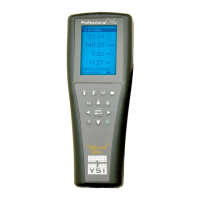Preparing Nitrate Calibration Solution
We recommend using YSI calibration solutions whenever possible. However, qualified users can save cost by
following these recipes for 1 and 100 mg/L nitrate standards. Other concentrations can be made by altering the
amount of potassium nitrate. All other concentrations should remain unchanged. It is important to note that some
of these chemicals are hazardous and therefore, the standards should only be prepared by qualified chemists in
laboratories where proper safety precautions are possible. It is the responsibility of the user to obtain and study
the MSDS for each chemical and to follow the required instructions with regard to handling and disposal of these
materials.
You will need: Solid Potassium Nitrate or a certified 1000 mg/l NO
-
3
-N from a supplier, Magnesium Sulfate, high
purity water, good quality analytical balance, 1000 ml volumetric flask, accurate volumetric measuring devices for
100 ml, 10 ml and 1 ml of solution, and 1000 ml glass or plastic storage vessels.
100 mg/L standard
: Accurately weigh 0.7222 g of anhydrous potassium nitrate and transfer quantitatively into a
1000 ml volumetric flask. Add 1.0 g of anhydrous magnesium sulfate to the flask. Add approximately 500 ml of
water to the flask, swirl to dissolve all of the reagents, and then dilute to the volumetric mark with distilled or
deionized water. Mix well by repeated inversion and then transfer the 100 mg/L standard to a storage bottle.
Rinse the flask extensively with water prior to its use in the preparation of the 1 mg/l standard. Alternatively, 100
mL of certified 1000 mg/L NO
-
3
-N standard can be used in place of the solid potassium nitrate.
1 mg/L standard
: Accurately measure 10.0 mL of the above 100 mg/L standard solution into a 1000 mL
volumetric flask. Add 1.0 g of anhydrous magnesium sulfate to the flask. Add approximately 500 mL of distilled or
deionized water, swirl to dissolve the solid reagents, and then dilute to the volumetric mark with water. Mix well
by repeated inversion and then transfer the 1 mg/L standard to a storage bottle.
Recipes are given for 1 and 100 mg/L. Other concentrations can be made by altering the amount of potassium
nitrate. All other concentrations should remain unchanged.
TROUBLESHOOTING TIPS
Typical working life for nitrate sensors is approximately 3-6 months depending on use, storage and maintenance.
Proper storage and maintenance generally extends the sensor’s working life.
If you get error messages during a nitrate calibration, check the following:
1. Ensure the nitrate solutions are good and not expired
2. Ensure that the nitrate sensor is installed in the correct port of the cable and the correct ISE is enabled in the
Sensor Setup menu.
a. If using a nitrate sensor in a 6051020 cable, ensure the sensor is installed in port 1.
b. If using a nitrate sensor in a 60510, 6051020 or 6051030 cable, nitrate should be enabled in ISE1 of
the instrument’s Sensor Setup menu.
c. If using a nitrate sensor in a 6051010 or Quatro cable, check to see if the nitrate sensor is installed in
port 1 or port 2. If the nitrate sensor is installed in port 1, enable nitrate in ISE1 of the Sensor Setup
menu. If the nitrate sensor is installed in port 2, enable nitrate in ISE2 of the Sensor Setup menu.
Note: If using with a pH or ORP sensor, it is recommended to install the pH or ORP sensor in port 1
and the nitrate sensor in port 2.
3. If using a 6051010 or Quatro cable, you must have a sensor installed in port 1 for port 2 to operate.
Additionally, ensure that the sensor installed in port 1 is in good working order. In 6051010 and Quatro
cables, the sensors installed in port 1 and
port 2 use the reference from the sensor installed in port 1 only.
Therefore, if the sensor installed in port 1 is not working properly, the readings from the sensor installed in
port 2 will be erroneous as well.
19

